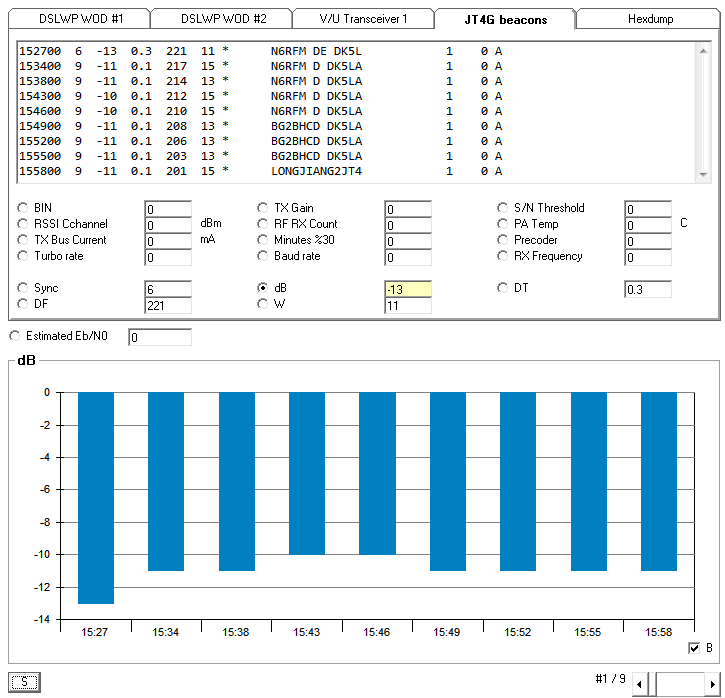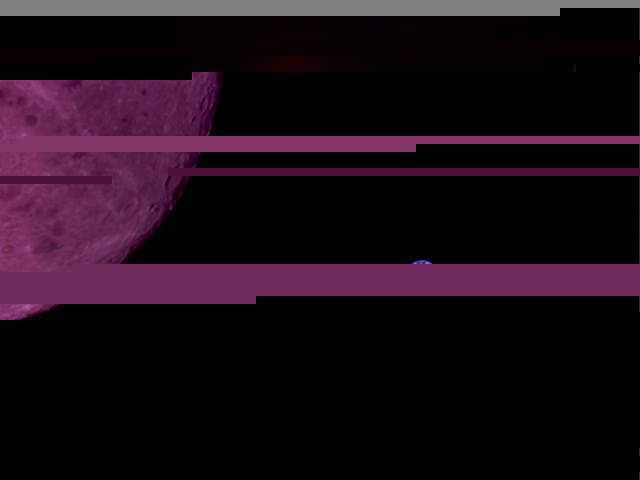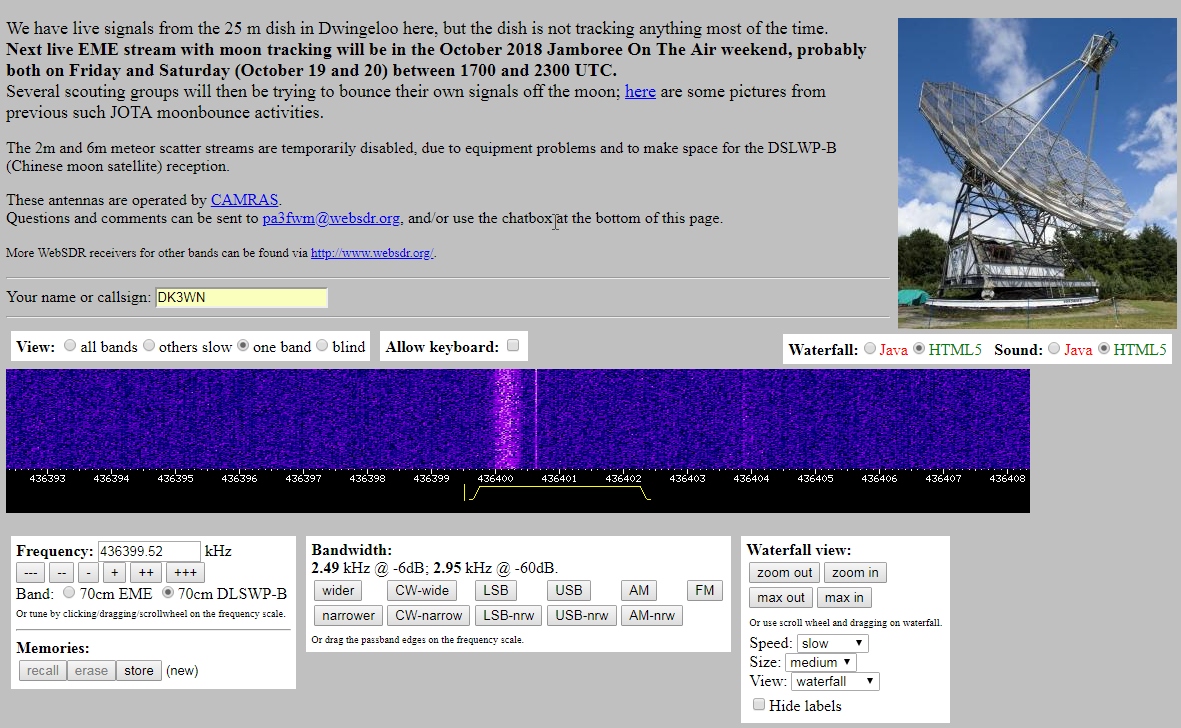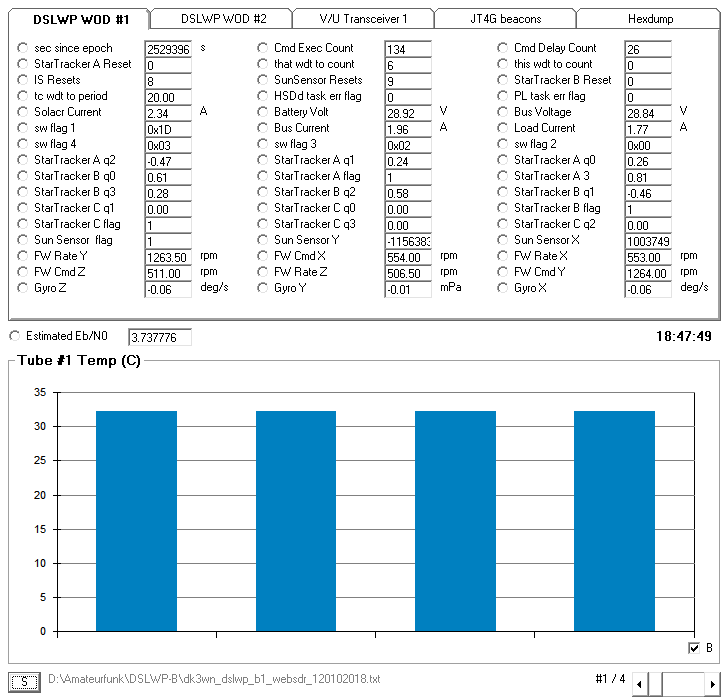DSLWP = Discovering the Sky at Longest Wavelengths Pathfinder
| Satellite | Status | NORAD | Uplink | Downlink | Beacon | Mode | Callsign | Reports | Info | IARU freq coord | Telemetry Decoder |
|---|---|---|---|---|---|---|---|---|---|---|---|
| DSLWP-A | INACTIVE | 43471 | 435.425 436.425 |
250/500 bps GMSK/ JT4G |
BJ1SM | latest report | details | YES |  |
||
| DSLWP-B | ACTIVE (scheduled) | 43472 | 435.400 436.400 |
500 bps GMSK/ JT4G |
BJ1SN | latest report | details | YES |  |

As a part of the Chang’e-4 lunar far side mission, two formation flying microsatellites were launched to the moon on May 20, 2018 at 21:28 UTC.
The microsatellites will be launched into a 200 km × 9000 km lunar elliptical orbit by a CZ-4C rocket, together with the L2 relay satellite. The main payload of these microsatellites are synchronized receivers in 1 – 30 MHz range, acting as an interferometer, to investigate radio radiation from celestial bodies in this band. The moon will shield the radio radiation from earth and sun, make it a unique position for this measurement. Distance between two satellites will be adjusted between 1 km and 10 km to provide a variable baseline.
The project is led by Harbin Institute of Technology, and has payload and science team from National Space Science Center, CAS and National Astronomical Observatories, CAS. There will also be a camera developed by King Abdulaziz City for Science and Technology of Saudi Arabic onboard satellite B.
The collision of DSLWP-B with the Moon is expected on July 31, putting an end to the mission.
EPS
• Triple-junction GaAs solar cells
• 18650 Li-ion batteries
• 28V power bus
OBDH
• BM3803 Spark V8 processor for OBC
• Payload controller with mess storage
Communication
• S-band (USB) for TT&C
• X-band for high speed data (1 Mbps)
• VHF/UHF amateur radio
S-band ISL, camera & LED for relative navigation
ADCS
• Flywheels x 4
• Star trackers x 2
• Gyroscope + accelerometer
Propulsion
• Monopropellant (hydrazine)
• 13.5 kg fuel for 660 m/s ΔV
• 4 x 5N thrusters for injection maneuver
• 4 x 0.2N thrusters for flywheel unload & formation-flying
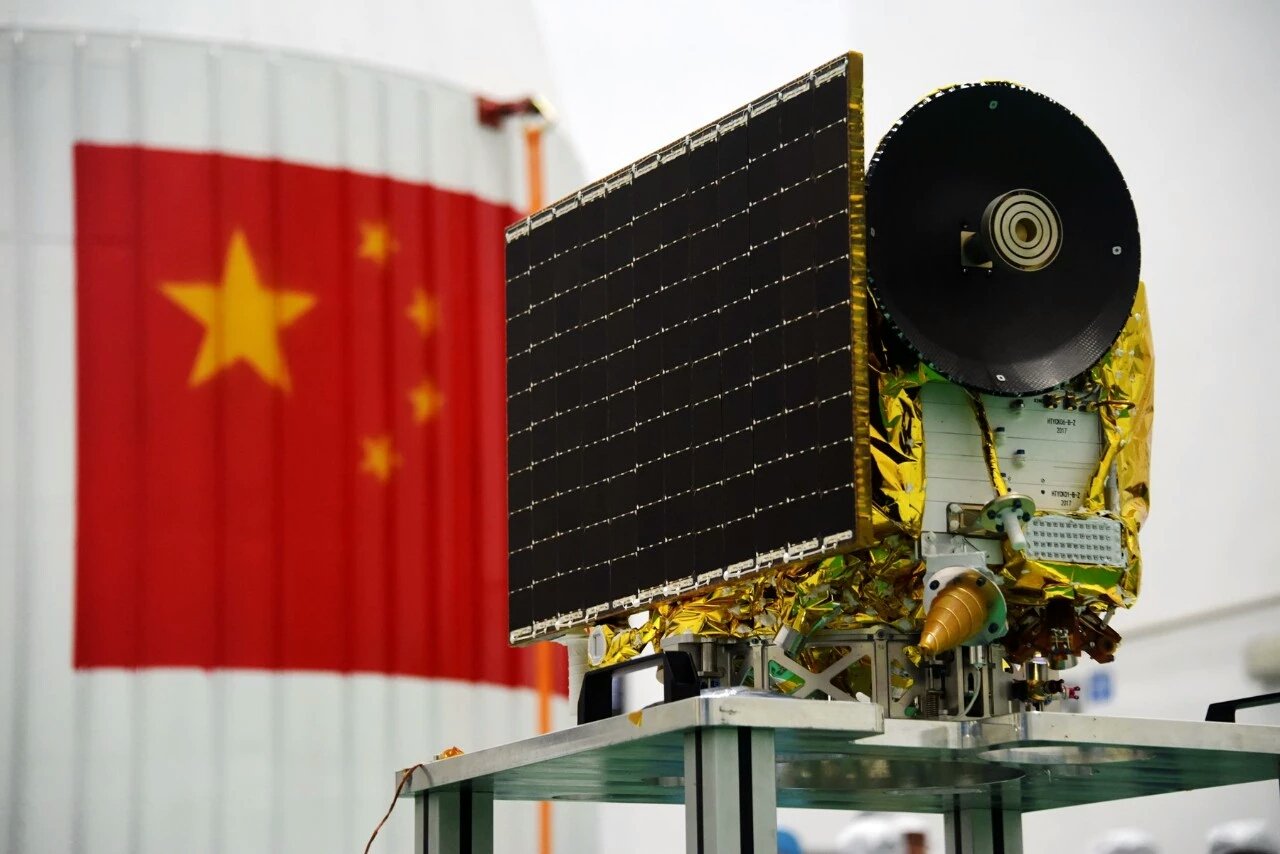
DSLWP is a lunar formation flying mission for low frequency radio astronomy, amateur radio and education, consists of 2 microsatellites. The amateur radio station onboard DSLWP-A1 will provide telecommand uplink and telemetry / digital image downlink. An open telecommand is also designed to allow amateurs to send commands to take and download an image. The designed lifetime of the satellite is 1 year. The mission will last during its entire lifetime.
The DSLWP satellites have a volume of about 50x50x40 cm3 and a mass of about 47 kg. 2 linear polarization antennas are mounted along and normal to the flight direction. The satellite is 3-axis stabilized. The subsystems within the satellite provide the following functions: communication, electric power supply, on-board data handing, attitude and orbit control, structure and thermal control and payload. The satellite is powered by solar panels and Li-ion batteries. The solar panel can generate 50 W of power in sunlight. The capacity of the Li-ion batteries is 160 Wh. The long-term power consumption is about 35 W in total, include COM, OHDH and AOCS. The power budget is about 30% while payload off and in sunlight.


Flight trajectories of relay satellite
Link Budget
Distance: 400000 km
Frequency: 437 MHz
TX Power: 33 dBm
TX Gain: -6 dBi
Path Loss: 197.3 dB
Ant Polar Loss: 3 dB
RX Gain: 26 dBi
Noise Figure: 2 dB
Data rate: 125 bps
Eb/No Threshold: 2.6 dB
Implemention Loss: 2 dB
Margin: 2.1 dB
Modulation
250 baud GMSK with r=1/2 turbo codes *(beacon every 5 min)
500 baud GMSK with r=1/4 turbo codes
JT4G *(beacon every 10 min)
On 11 June 2018 JT4G was successfully switched on by ground telecommand for the first time.
Telemetry



Links
https://github.com/bg2bhc/gr-dslwp
LiveCD ISO
http://destevez.net/2018/05/dslwp-bs-journey-to-the-moon-part-i/
http://destevez.net/2018/05/dslwp-bs-journey-to-the-moon-part-ii/
http://destevez.net/2018/06/dslwp-bs-journey-to-the-moon-part-iii/
http://destevez.net/2018/06/dslwp-b-first-jt4g-test/
https://gbtimes.com/change-4-lunar-far-side-satellite-named-magpie-bridge-from-folklore-tale-of-lovers-crossing-the-milky-way
Currently we see two different types of telemetry:
DSLWP WOD
19 30 02 02 00 C0 18 AC 00 42 00 C1 00 00 D4 98 2B 68 13 00 06 00 00 00 04 00 00 F0 07 3A 07 45 05 09 03 35 04 56 29 FB 2D 3C FB 5B B7 38 E6 B9 39 00 7C D3 76 80 0B EA C5 E0 01 0F C6 9B 70 BD 93 EB 00 E9 2B 24 60 69 D6 D7 00 01 00 00 00 00 00 00 00 00 00 00 00 00 00 00 00 00 01 3C 47 EA 5F BB 50 54 97 01 00 DF 00 E0 04 4B 04 46 04 D8 04 DE 05 C6 05 C6 FF FF 07 AF FF FE D0 26 FF FF 07 63 02 05 00 00 E7 FF 04 FF 31 FC C5 00 CF FE 05 73 34 78 DF FB 8C 2D 5F 01 8D 02 74 02 2A 02 51 02 F8 01 3F 02 0F 01 4A 02 18 02 0E 02 56 02 56 02 5E 00 00 00 00 00 C3 08 82 32 00 00 00 00 00 00 0C C3 08 82 32 00 00 00 00 00 00 0A C0 C0 C0 C0 C0 C0 C0 C0 C0 C0 C0 C0 C0 C0 C0 C0 C0

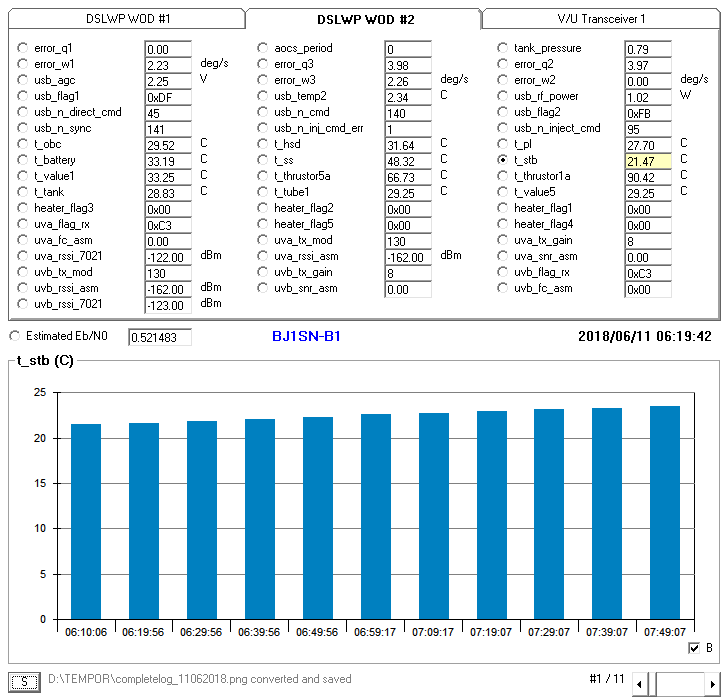
DSLWP V/U Transceiver 1 Telemetry
19 30 11 11 00 C0 18 0F EA DA 00 48 00 00 C3 08 82 32 DB DC 00 00 17 B5 67 B4 22 00 00 00 9D 9D 00 00 00 12 00 00 00 00 00 00 00 00 00 00 00 00 00 00 00 00 01 69 04 06 00 00 00 D4 A9 C2 00 00 00 00 90 00 03 00 4A 00 00 00 00 13 6A C5 42 4A 31 53 4E 2D 42 31 C0 C0 C0 C0 C0 C0 C0 C0 C0 C0 C0 C0 C0 C0 C0 C0 C0 C0 C0 C0 C0 C0 C0 C0 C0 C0 C0 C0 C0 C0 C0 C0 C0 C0 C0 C0 C0 C0 C0 C0 C0 C0 C0 C0 C0 C0 C0 C0 C0 C0 C0 C0 C0 C0 C0 C0 C0 C0 C0 C0 C0 C0 C0 C0 C0 C0 C0 C0 C0 C0 C0 C0 C0 C0 C0 C0 C0 C0 C0 C0 C0 C0 C0 C0 C0 C0 C0 C0 C0 C0 C0 C0 C0 C0 C0 C0 C0 C0 C0 C0 C0 C0 C0 C0 C0 C0 C0 C0 C0 C0 C0 C0 C0 C0 C0 C0 C0 C0 C0 C0 C0 C0 C0 C0 C0 C0 C0 C0 C0 C0 C0 C0 C0 C0 C0 C0 C0
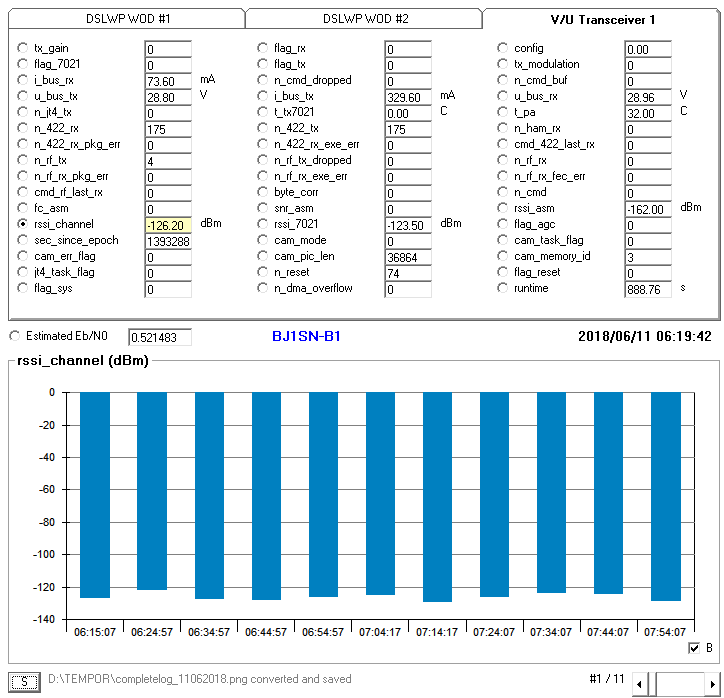
GMSK 500 baud GMSK with r=1/4 turbo codes [20 Oct 2018]
JT4G


original beacon time: 16 June 2018 09:40:05 UTC

DSLWP-B1 JT4G audio file 16 June 2018 09:40 UTC
Dani, EA4GPZ added also an SNR estimator. This recording has an SNR of -15dB. The python script used to perform the detection is dslwp_jt4.py.

Remarks: You should use python3 and convert your WAV file to a sample rate multiple of 35.
sox dslwp_jt4g.wav dslwp_jt4g_res.wav rate 11025
SSDV
I decoded these two images from the hexdump of my received data on the 14 Aug 2018.


Great thanks again to Dani, EA4GPZ for his distinguished article about the DSLWP-SSDV format and the usage of his ssdv_sort.py

image id: 45

image id: 46
SSDV frame
**** TM Frame Header
version_number = 0x0
spacecraft_id = 0x193
virtual_channel_id = 0x1
spare = 0x0
master_frame_count = 6
virtual_channel_frame_count = 0
first_header_pointer = 255
* MESSAGE DEBUG PRINT PDU VERBOSE *
()
pdu_length = 218
contents =
0000: 2d 00 00 28 1e 0a 00 00 00 e7 0b 32 f0 09 a4 65
0010: e0 b6 0f f3 ae 89 2d 2e 77 db a9 1b 3e 0e 4a e0
0020: 9e 01 a6 8e 49 e4 7e 75 32 7d c9 63 40 53 d5 b1
0030: ed 53 46 a4 1e 07 e5 d0 d0 91 43 fa 27 4f c6 9a
0040: e4 10 3b f6 a2 d7 d4 a7 a1 1b 12 00 c8 24 54 6d
0050: 91 d0 8f 71 42 69 6e 0d db fa 1a cd b7 db f0 a6
0060: 9e 9d f7 0a 13 7b 85 dd 86 1e 9c f3 9e f4 8c 40
0070: 1f 29 e3 d3 34 32 75 23 5c 92 71 9a 4c 64 74 e6
0080: 86 95 ff a0 7d 86 9c 67 b8 a6 92 01 20 ff 3a 5a
0090: 5c 96 ec 34 f0 40 06 9c 09 cf 5e 3d 29 89 8f c7
00a0: 1c fe 54 8c a4 0c f5 1e b4 ec d1 57 e9 fd 7f 44
00b0: 43 39 e9 47 00 12 30 2a 5a 20 42 dd 05 35 b9 1d
00c0: fe 94 92 15 ff a1 08 ca 83 cd 30 e4 75 14 95 85
00d0: b0 80 71 93 47 3e f4 e6 80 29
***********************************
image ID is 0x2D, this is packet number 0
DSLWP-B uses the normal mode, so there are 205 bytes of payload data per frame.
Sync byte, packet type and FEC symbols are not sent.
Step-by-Step: How to decode the image
1. Save the output of the decoder into a text file (e.g. DSLWP-B_10Oct18_1400-1600Z)
2. Open text file with my DSLWP telemetry parser
3. Generate the binary file dslwp_ssdv.bin (e.g. http://www.dk3wn.info/files/dslwp_ssdv.bin)
4. Use SSDV to decode the image from binary file. It can be obtained from Dani, EA4GPZ here:
https://github.com/daniestevez/ssdv
> $ ssdv -d -D -v dslwp_ssdv.bin dslwp_ssdv.jpg
Great thanks to Bob, N6RFM for the input data 🙂

taken 09 Oct, 05:00 UTC – downloaded 10 Oct 14:00 UTC
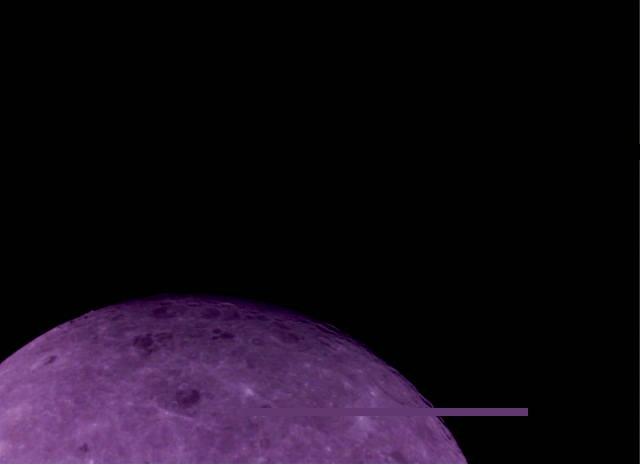
16 Oct 2018 – I missed only two packets 🙂 … great teamwork 4Z5CP, YL3CT and DK5LA 🙂
Status
After lunar injection, TLE is no longer useful.
22 May 2018 We lost the contact of satellite A on S band after an orbit adjustment. We just tried to switch on UHF, but we don’t know if it works or not.
23 May 2018 So far we know -A went silent even on S band. -B is QRT “temporarily” on UHF. We are awaiting an update from @bg2bhc. Given distance absent very favorable link budget, JT4 may be good choice when -B comes back.
25 May 2018 DSLWP-B now orbiting moon
31 May 2018 DSLWP Live CD update, for the tests comming this weekend – Planning DSLWP-B UHF tests, 31 May 16:00 UTC to 31 May 18:00 UTC and 1 Jun 02:00 UTC to 1 Jun 04:00 UTC, 250 bps GMSK and JT4G for 435.400 MHz and 250 bps GMSK for 436.400 MHz
31 May 2018 both tests cancelled 🙁
2 June 2018 @bg2bhc DSLWP-B UHF new test plan, 2 Jun 22:00 – 23:40 UTC, 3 Jun 2:30 – 3:30 UTC, 250 bps GMSK and JT4G for 435.4, and 250 bps GMSK for 436.4
2 June 2018 The test for DSLWP-B UHF is now scheduled from 2 Jun 22:00 UTC to 2 Jun 23:50 UTC, and from 3 Jun 02:30 UTC to 3 Jun 03:30 UTC.
We will change the mode of the transmitters to 250 bps GMSK and JT4G on 435.4 MHz (GMSK every 5 min, JT4G every 10 min, JT4G has higher priority), and 250 bps GMSK on 436.4 MHz (every 5 min). Corresponding demod grcs should be used.
4 June 2018 DSLWP-B UHF test, 4 Jun 22:00 – 23:40 UTC, 5 Jun 8:00 – 10:00 UTC, 250 bps GMSK for 435.4 and 436.4
7 June 2018 subsequent tests for DSLWP UHF are planned from 7 Jun 22:00 UTC to 8 Jun 00:00 UTC, and from 8 Jun 05:45 UTC to 8 Jun 06:45 UTC. The mode is 250 bps GMSK for both 435.4 MHz and 436.4 MHz.
10 June 2018 03:40 UTC to 10 Jun 05:40 UTC
10 June 2018 22:00 UTC to 11 Jun 00:00 UTC
11 June 2018 06:00 UTC to 11 Jun 08:00 UTC
11 June 2018 14:00 UTC to 11 Jun 16:00 UTC
13 June 2018 IW1DTU reported strong X-band signals on 8478.000 MHz from DSLWP-B
16 June 2018 09:00 to 11:00 UTC (GMSK, JT4G) – first activation of JT4G at 09:30 UTC
16 June 2018 22:00 to 17 Jun 00:00 UTC (only GMSK)
19 June 2018 08:25 to 10:25 UTC
22 June 2018 21:00 to 23:00 UTC – JT4G
23 June 2018 11:00 to 13:00 UTC
23 June 2018 22:00 to 24 June 2018 00:00 UTC
24 June 2018 12:00 to 24 June 2018 14:00 UTC – canceled
30 June 2018 00:00 to 30 June 2018 02:00 UTC
30 June 2018 05:00 to 30 June 2018 07:00 UTC
30 June 2018 16:00 to 30 June 2018 18:00 UTC
1 July 2018 07:00 to 1 July 2018 09:00 UTC
14 July 2018 07:30 UTC to 09:30:00 UTC
14 July 2018 15:00 UTC to 17:00 UTC
15 July 2018 08:30 UTC to 10:00 UTC
15 July 2018 16:00 UTC to 18:00 UTC
28 Jul 2018 16:00 to 18:00 UTC
29 Jul 2018 01:50 to 03:50 UTC
29 Jul 2018 16:00 to 18:00 UTC
3 Aug 2018 23:30 to 4 Aug 01:30 UTC
4 Aug 2018 07:00 to 09:00 UTC
5 Aug 2018 00:30 to 02:30 UTC
5 Aug 2018 07:30 to 09:30 UTC
12 Aug 07:00 to 09:00 UTC GMSK (B0+B1) and JT4G/SSDV (B1)
12 Aug 13:00 to 15:00 UTC GMSK and JT4G (B0+B1)
14 Aug 2018 09:00 to 11:00 UTC
16 Aug 2018 09:00 to 11:00 UTC
18 Aug 2018 08:30 to 10:30 UTC
18 Aug 2018 16:30 to 18:30 UTC
18 Aug 2018 22:00 to 19 Aug 00:00 UTC
23 Aug 2018 12:30 to 14:30 UTC
25 Aug 2018 03:00 to 05:00 UTC
25 Aug 2018 14:00 to 16:00 UTC
25 Aug 2018 20:00 to 22:00 UTC
26 Aug 2018 03:30 to 05:30 UTC
12 Sep 2018 04:00 to 06:00 UTC
14 Sep 2018 14:40 to 16:40 UTC – images, JT4G
14 Sep 2018 20:00 to 22:00 UTC
16 Sep 2018 16:00 to 18:00 UTC – JT4G
21 Sep 2018 20:00 to 22:00 UTC
22 Sep 2018 01:40 to 03:40 UTC
23 Sep 2018 02:20 to 04:20 UTC
23 Sep 2018 13:30 to 15:30 UTC
29 Sep 2018 07:00 to 09:00 UTC
29 Sep 2018 19:00 to 21:00 UTC
30 Sep 2018 02:30 to 04:30 UTC – JT4G
30 Sep 2018 08:30 to 10:30 UTC
4 Oct 2018 19:25 to 21:25 UTC
6 Oct 2018 13:55 to 15:55 UTC – JT4G
7 Oct 2018 05:20 to 07:20 UTC – JT4G
7 Oct 2018 10:00 to 12:00 UTC – images, no B1 JT4G
8 Oct 2018 08:21 to 10:21 UTC – images, no B1 JT4G
8 Oct 2018 13:00 to 15:00 UTC – GMSK, no JT4G
9 Oct 2018 05:25 to 07:25 UTC
10 Oct 2018 02:18 to 04:18 UTC
10 Oct 2018 14:00 to 16:00 UTC – image, B1 JT4G repeater (no beacons)
12 Oct 2018 17:52 to 19:52 UTC
13 Oct 2018 15:03 to 17:03 UTC – no B1 JT4G
14 Oct 2018 07:00 to 09:00 UTC
14 Oct 2018 12:16 to 14:16 UTC
15 Oct 2018 08:50 to 10:50 UTC
16 Oct 2018 16:00 to 18:00 UTC – B1 images download
17 Oct 2018 16:00 to 18:00 UTC – B1 images download
18 Oct 2018 16:30 to 18:30 UTC – B1 images download
19 Oct 2018 16:50 to 18:50 UTC – B1 download missing image chunks, 500 bps B0/B1 enabled
20 Oct 2018 17:10 to 19:10 UTC – B0 GMSK, 500bps, JT4G, B1 only GMSK beacon 500bps, no JT4G -> PI9CAM streaming webSDR
21 Oct 2018 13:30 to 15:30 UTC
21 Oct 2018 22:40 to 00:40 UTC – B1 only GMSK, no JT4G
22 Oct 2018 23:40 to 01:40 UTC
23 Oct 2018 17:40 to 19:40 UTC
24 Oct 2018 18:00 to 20:00 UTC
25 Oct 2018 18:50 to 20:50 UTC
27 Oct 2018 05:00 to 07:00 UTC
27 Oct 2018 17:20 to 19:20 UTC
31 Oct 2018 15:40 to 17:40 UTC
01 Nov 2018 07:30 to 09:30 UTC
02 Nov 2018 18:30 to 20:30 UTC
03 Nov 2018 10:10 to 12:10 UTC
03 Nov 2018 19:20 to 21:20 UTC
07 Nov 2018 08:13 to 10:13 UTC
08 Nov 2018 09:40 to 11:40 UTC
09 Nov 2018 12:00 to 14:00 UTC
10 Nov 2018 14:00 to 16:00 UTC
11 Nov 2018 13:30 to 15:30 UTC
11 Nov 2018 17:45 to 19:45 UTC
12 Nov 2018 14:59 to 16:59 UTC
14 Nov 2018 09:28 to 11:28 UTC
15 Nov 2018 06:43 to 08:43 UTC
17 Nov 2018 18:30 to 20:30 UTC
18 Nov 2018 00:00 to 02:00 UTC
18 Nov 2018 20:00 to 22:00 UTC
19 Nov 2018 16:00 to 18:00 UTC
21 Nov 2018 17:00 to 19:00 UTC
22 Nov 2018 18:00 to 20:00 UTC
24 Nov 2018 02:30 to 04:30 UTC
25 Nov 2018 20:30 to 22:30 UTC
———————————————–
13 Jan 2019 12:15 to 14:15 UTC
19 Jan 2019 17:25 to 19:25 UTC
24 Jan 2019 DSLWP-B has successfully made a maneuver to reduce its perigee. The sat will end up with an impact to the moon in about August 2019 to avoid space junk.
27 Feb 2019 07:30 to 09:30 UTC
27 Feb 2019 21:30 to 23:30 UTC
15 Mar 2019 03:50 to 05:50 UTC
15 Mar 2019 20:25 to 22:25 UTC
17 Mar 2019 15:45 to 17:45 UTC
20 Apr 2019 06:00 to 08:00 UTC
21 Apr 2019 00:00 to 02:00 UTC
27 Apr 2019 06:30 to 08:30 UTC
28 Apr 2019 00:00 to 02:00 UTC
15 May 2019 07:40 to 09:40 UTC
15 May 2019 16:10 to 18:10 UTC
19 May 2019 05:30 to 07:30 UTC
20 May 2019 14:28 to 16:28 UTC
20 May 2019 22:20 to 21 May 00:20 UTC
22 May 2019 04:20 to 06:20 UTC
03 Jun 2019 03:05 to 05:05 UTC
04 Jun 2019 07:00 to 09:00 UTC
05 Jun 2019 07:00 to 09:00 UTC
06 Jun 2019 07:00 to 09:00 UTC
07 Jun 2019 08:00 to 10:00 UTC
30 Jun 2019 05:30 to 07:30 UTC
01 Jul 2019 05:30 to 07:30 UTC
02 Jul 2019 18:00 to 20:00 UTC
03 Jul 2019 06:00 to 08:00 UTC
04 Jul 2019 06:30 to 08:30 UTC
05 Jul 2019 07:30 to 09:30 UTC
09 Jul 2019 12:30 to 14:30 UTC
10 Jul 2019 13:50 to 15:50 UTC
12 Jul 2019 02:00 to 04:00 UTC
12 Jul 2019 16:30 to 18:30 UTC
14 Jul 2019 19:00 to 21:00 UTC
15 Jul 2019 12:00 to 14:00 UTC
17 Jul 2019 04:40 to 06:50 UTC
18 Jul 2019 21:50 to 23:50 UTC
20 Jul 2019 14:20 to 16:20 UTC
21 Jul 2019 05:30 to 07:30 UTC
22 Jul 2019 06:14 to 08:14 UTC
22 Jul 2019 22:40 to 23 Jul 00:40 UTC
23 Jul 2019 23:20 to 24 Jul 01:20 UTC
25 Jul 2019 00:30 to 02:30 UTC
26 Jul 2019 10:55 to 12:55 UTC
27 Jul 2019 02:30 to 04:30 UTC
28 Jul 2019 03:30 to 05:30 UTC
29 Jul 2019 00:15 to 02:15 UTC
29 Jul 2019 04:30 to 06:30 UTC
29 Jul 2019 20:00 to 22:00 UTC
30 Jul 2019 05:30 to 07:30 UTC
30 Jul 2019 16:20 to 18:20 UTC
31 Jul 2019 06:30 to 08:30 UTC
31 Jul 2019 13:24 to 15.24 UTC
31 Jul 2019*** collision of DSLWP-B against the lunar surface will happen at ~14:20 UTC ***
01 Aug 2019 05:30 to 07:30 UTC
my very first RX of DSLWP-B1 (436.400 MHz) from lunar orbit
8 June 2018, 06:10 UTC – moon elevation 37 deg, range 381.200km

10 June 2018 03:40 UTC range 362.500km elevation 30 deg to
10 June 2018 05:40 UTC range 360.000km elevation 35 deg
made some experiments with RHCP / LHCP (doesn’t work). FT736+SDR-IQ (best), Airspy and RTL-SDR (not so good)
B0 is much weaker than B1, unfortunately no decodes yet
![]()
436.400 MHz (B1)
![]()
![]()
… and my first decode:

11 Jun 06:00 UTC el. 35 deg range 354530 km to
11 Jun 08:00 UTC el. 49 deg range 354160 km


I used AirSpy SDR for the first two beacons.
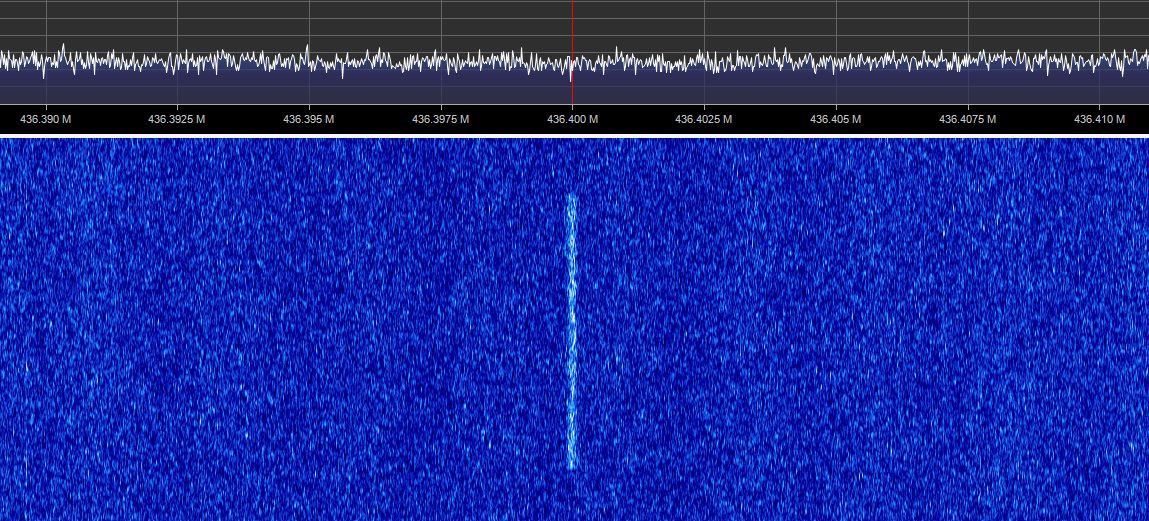
MASPRO 435HS20 2×20 el-X Yagi, 13.2 dBD RHCP SP-7000 ssb-electronic 20db/0.9
15 mtr H2000-Flex coax



20 Oct 2018 – the @radiotelescoop is experimenting with streaming the signal from DSLWP-B through Web-SDR. See websdr.camras.nl:8901
If you listen to DSLWP-B1 you can decode it online 🙂
